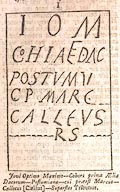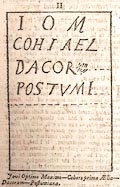







 next page
next pageOBSERVATIONS on five Roman inscriptions after the manner of Mr Horsley.


Jovi Optimo Maximo - Cohors prima AElia Dacorum - Postumiana - cui praeest Marcus - Callecus (Caelius) - Superstes Tribunus.


Jovi Optimo Maximo - Cohors prima AElia - Dacorum - Postumiana.
I, II. THE two first are standing in the yard belonging to the farm house at Burdoswald. I understood from the people of the place, that they had dug them up about four or five years ago, within about a stone's throw of the wall of Severus, and a little to the east of the station. They are both to Jupiter the best and greatest, by the Cohors prima AElia Dacorum, which Cohort is well known to have been stationed at this place. The letters do not seem very well cut, and yet are not so rude and uncouth, as they are in many other inscriptions. They are, however, very differently disposed in them, tho' the stones seem to have been inscribed within a few years of one another. In the first the O is in the belly of the C in Cohors, and the E and L in the same line are joined together by a ligature; and DAC is put for Dacorum. In the second there is no such inequality of the letters, and the word Dacorum has been at its full length. The reason of this I take to be, that in the second the name of the commander of the Cohort has been shorter, than in the first, where it seems to consist of three distinct words, to make room for which, the stones being of the same size, what fills up the second and third line in the other is in this crowded into the second. Hence it appears that this Cohort must have had two commanders, at least (tho' the name of one of them we do not know) during the seven (a) years of Postumius's power over the western parts of the empire. For I make no doubt that the third line in the first, and the fourth in the second inscription is to be read Postumiana, and that the Cohort has this appellation from its taking part with Postumius one of the thirty tyrants, whose government was acknowledged thro' all Gaul and Britain, and whose coins are frequently found in our island. We have a short account of him and his son in Trebellius Pollio (b). In other inscriptions we find this Cohort called Gordiana (c) from the emperor Gordian, and Tetriciana is given us only by Mr Horsley (d), and I think it is well supported by the two inscriptions that we are now considering, which, and those two just now referred to, seem mutually to throw light upon and confirm each other. The name of the commander in the first inscription seems to have been Marcus Callecus Superstes, or perhaps Marcus Coelius Superstes; for it is not unlikely, that the first appearance of an L has been really an E, and I am apt to think that I have made some mistake in the fifth letter. But, be this as it will, tho' in the next line with only RS, it does not seem to be too hasty a supposition, that the word has been Superstes, as before the R there is just space enough for the four first letters, and after it for the three last. We have the same Cognomen in other inscriptions (e); and Marcus Coelius Superstes
(a) Hic vir in bello fortissimus, &c. talem se praebuit per anos septem, ut Gallias instauraverit &c. Trebell. Poll. Trigint. Tyrann.
(b) Ibid.
(c) See Cambden, pag.1039, and Horsley's Britannia Romana, Cumberland VII, and VIII.
(d) Ibid p.253.
(e) See Gruter; Gordon's Itenarium Septentrionale pl.33, fig.1. p.75; and Horsleys's Brit. Rom. Northumberland, xxxvi, and lxxxvi.


 Gents Mag 1752 p.106
Gents Mag 1752 p.106